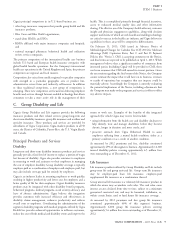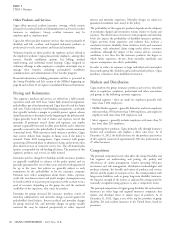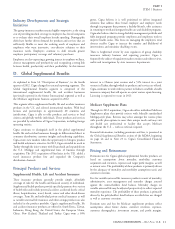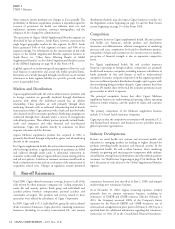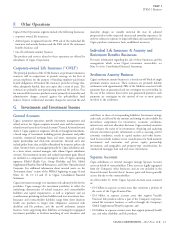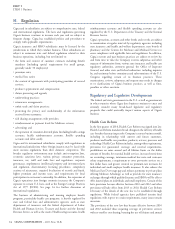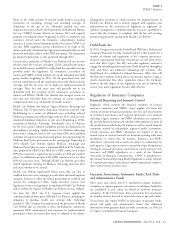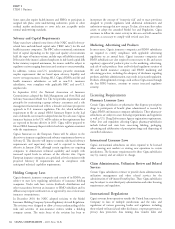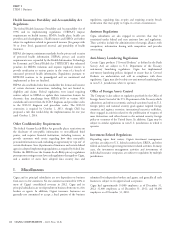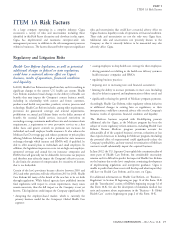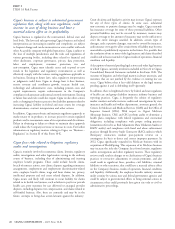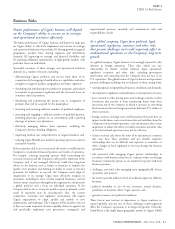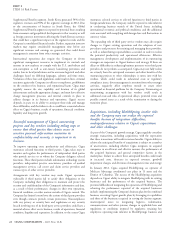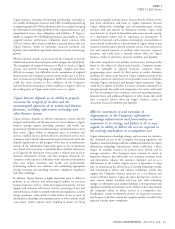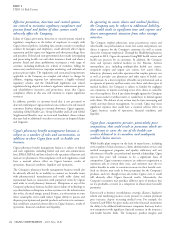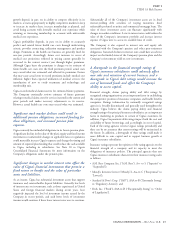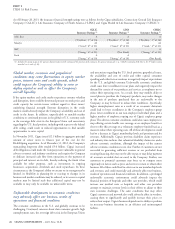Cigna 2012 Annual Report Download - page 38
Download and view the complete annual report
Please find page 38 of the 2012 Cigna annual report below. You can navigate through the pages in the report by either clicking on the pages listed below, or by using the keyword search tool below to find specific information within the annual report.PART I
ITEM 1 Business
Some states also require health insurers and HMOs to participate in incorporate the concept of ‘‘enterprise risk’’ and to enact provisions
assigned risk plans, joint underwriting authorities, pools or other designed to provide regulators with additional information and
residual market mechanisms to cover risks not acceptable under authority to manage this new concept. To date, a few states have taken
normal underwriting standards. action to adopt the amended Model Act and Regulation. Cigna
continues to follow the states’ activity in this area and will amend its
processes as necessary to comply with revised state laws.
Solvency and Capital Requirements
Many states have adopted some form of the NAIC model solvency-
Marketing, Advertising and Products
related laws and risk-based capital rules (‘‘RBC rules’’) for life and
health insurance companies. The RBC rules recommend a minimum In most states, Cigna’s insurance companies and HMO subsidiaries
level of capital depending on the types and quality of investments are required to certify compliance with applicable advertising
held, the types of business written and the types of liabilities incurred. regulations on an annual basis. Cigna’s insurance companies and
If the ratio of the insurer’s adjusted surplus to its risk-based capital falls HMO subsidiaries are also required in most states to file and secure
below statutory required minimums, the insurer could be subject to regulatory approval of products prior to the marketing, advertising,
regulatory actions ranging from increased scrutiny to conservatorship. and sale of such products. State and/or federal regulatory scrutiny of
life and health insurance company and HMO marketing and
In addition, various non-U.S. jurisdictions prescribe minimum advertising practices, including the adequacy of disclosure regarding
surplus requirements that are based upon solvency, liquidity and products and their administration, may result in increased regulation.
reserve coverage measures. During 2012, Cigna’s HMOs and life and Products offering limited coverage, such as those Cigna issues through
health insurance subsidiaries, as well as non-U.S. insurance the Star HRG business, continue to attract increased regulatory
subsidiaries, were compliant with applicable RBC and non-U.S. scrutiny.
surplus rules.
In September 2012, the National Association of Insurance
Licensing Requirements
Commissioners adopted the Risk Management and Own Risk and
Solvency Assessment Model Act. The Act provides requirements and
Pharmacy Licensure Laws
principles for maintaining a group solvency assessment and a risk Certain Cigna subsidiaries are pharmacies that dispense prescription
management framework and reflects a broader and more prospective drugs to participants of benefit plans administered or insured by
approach to U.S. insurance regulation. The Act, which includes a Cigna’s HMO and insurance company subsidiaries. These pharmacy-
requirement to file an annual ORSA Summary Report in the lead subsidiaries are subject to state licensing requirements and regulation
state of domicile, now must be adopted into law by each state. Cigna’s as well as U.S. Drug Enforcement Agency registration requirements.
insurance business in the U.S. will be subject to the requirements that Other laws and regulation affecting Cigna’s pharmacy-subsidiaries
are expected to become effective in 2015. Cigna will be prepared to include federal and state laws concerning labeling, packaging,
file an ORSA Summary Report with its lead state regulator consistent advertising and adulteration of prescription drugs and dispensing of
with the requirements. controlled substances.
Cigna’s businesses in the European Union will be subject to the
directive on insurance regulation and solvency requirements known as
International Licensure Laws
Solvency II. This directive will impose economic risk-based solvency
requirements and supervisory rules and is expected to become Cigna’s international subsidiaries are often required to be licensed
effective in January 2014, although certain regulators are requiring when entering new markets or starting new operations in certain
companies to demonstrate technical capability and comply with jurisdictions. The licensure requirements for these Cigna subsidiaries
increased capital levels in advance of the effective date. Cigna’s vary by country and are subject to change.
European insurance companies are capitalized at levels consistent with
projected Solvency II requirements and in compliance with
Claim Administration, Utilization Review and Related
anticipated technical capability requirements.
Services
Certain Cigna subsidiaries contract to provide claim administration,
Holding Company Laws
utilization management and other related services for the
Cigna’s domestic insurance companies and certain of its HMOs are administration of self-insured benefit plans. These Cigna subsidiaries
subject to state laws regulating subsidiaries of insurance holding may be subject to state third-party administration and other licensing
companies. Under such laws, certain dividends, distributions and requirements and regulation.
other transactions between an insurance or HMO subsidiary and its
affiliates may require notification to, or approval by, one or more state
International Regulations
insurance commissioners.
Cigna’s revenue from operations outside the United States exposes the
In December 2010, the NAIC adopted revisions to the Model
Company to laws of multiple jurisdictions and the rules and
Insurance Holding Company System Regulatory Act and Regulation.
regulations of various governing bodies and regulators, including
The revisions were designed to allow a better understanding of the
those related to financial and other disclosures, corporate governance,
risks and activities of non-insurance entities within a holding
privacy, data protection, data mining, data transfer, labor and
company system. The main focus of the revisions has been to
16 CIGNA CORPORATION - 2012 Form 10-K





